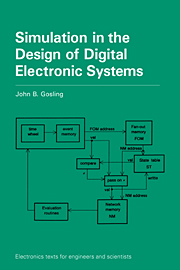Book contents
- Frontmatter
- Contents
- Preface
- 1 An introduction to the simulation of electronic systems
- 2 Electronic computer aided design (ECAD) systems
- 3 Design for testability
- 4 Exercising the design in simulation and test
- 5 Input/output of simulation and specification of models
- 6 Simulation algorithms
- 7 Models and model design
- 8 Timing verification
- 9 Fault simulation
- 10 Simulator features and extensions
- Appendix
- References
- Index
4 - Exercising the design in simulation and test
Published online by Cambridge University Press: 05 June 2012
- Frontmatter
- Contents
- Preface
- 1 An introduction to the simulation of electronic systems
- 2 Electronic computer aided design (ECAD) systems
- 3 Design for testability
- 4 Exercising the design in simulation and test
- 5 Input/output of simulation and specification of models
- 6 Simulation algorithms
- 7 Models and model design
- 8 Timing verification
- 9 Fault simulation
- 10 Simulator features and extensions
- Appendix
- References
- Index
Summary
Objectives and approaches
Objective
The first objective of any set of tests must be to show that the system does what it was designed to do. This means
does it perform the necessary functions correctly?
does it perform its function within the required time specification?
are there any circumstances, normal or unusual, under which it can get into a forbidden state from which it can only recover by drastic action (e.g. system reset)?
The above presumes that any fault or group of faults which could possibly occur would affect the operation of the system. If a fault or faults do not affect the operation then there must be some logic which is redundant. It will be assumed that none of the logic is redundant.
On the further assumption that the design is good, a second objective is to be capable of detecting any fault or group of faults within that system. However, there is some debate as to the level of detail into which it is necessary to go and this will be the subject of further discussion. The distinction between simulation testing and testing the manufactured hardware was made in Section 3.1.2.
Modelling faults
Faults in the design, as opposed to those which occur in production, cannot be ‘modelled’ in the usual sense of the word. A network description is entered into the simulator and this is a model of the network. If, as a result of simulation, outputs are obtained which are different from those expected from considering the specification, then the network as described to the simulator is fault.
- Type
- Chapter
- Information
- Simulation in the Design of Digital Electronic Systems , pp. 64 - 95Publisher: Cambridge University PressPrint publication year: 1993



